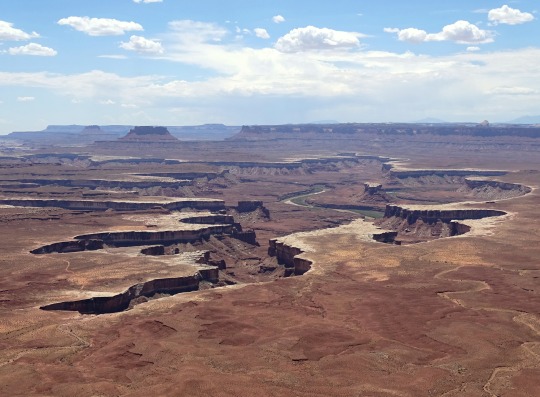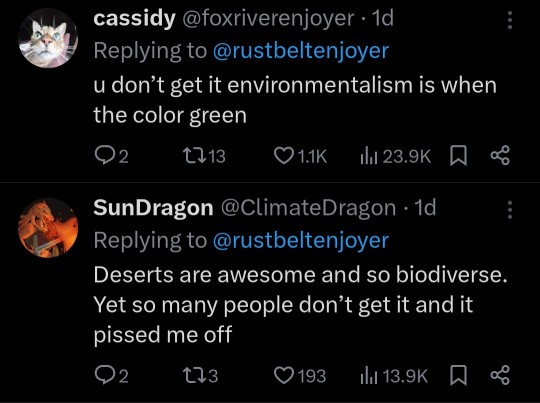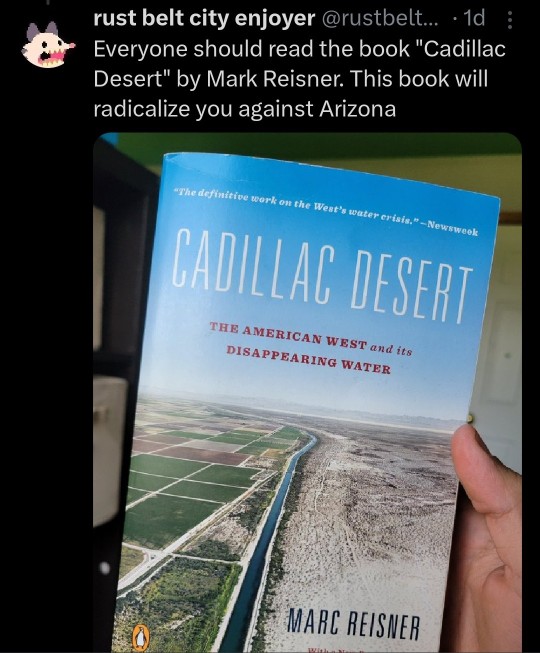#pinyon-juniper
Explore tagged Tumblr posts
Text
My first published paper!
Please check out my first published paper contribution! I was involved with the field work portion of this study as part of my master's degree in geography at the University of Utah. It's always exciting to expand my knowledge of geospatial technologies and evolve in the world of environmental science.
#geography#lidar#pinyon-juniper#big data#mapping#science#biomass#university of utah#remote sensing#ecology#environment#professional
4 notes
·
View notes
Text
bioware trying to throw me off my mission by being like "ooo look Emmrich is a botanist!! how relatable! think about him and his love of plants!" oh yeah then why isnt HE going crazy in Arlathan ID'ing the tree species the way I am. why hasn't he said anything about how the leaf litter on the ground is chok full of oak leaves but there's NOWHERE an oak tree to be found??? it's all apsen and pine and that one special one davrin points out (marpel). where are the oaks. WHERE ARE THE OAKS

#havin another Normal one tonight folks#this thoguht was so stupid i had to share it. i know its just bc their forest litter texture asset was Not designed for the trees they put#but also. I SEE YOU. I SEE IT#honestly tho i am in fact impressed that there's aspen trees And leaves on the ground + falling#they got the main one they're showcasing right so i dont blame them much#but botany brain... rip#ramblings#thedas ecology#dragon age#dragon age: veilguard#jade plays dav#also whenever i hear 'marple' im like did someone need to come up with a New Tree and just go uhhhh Maple no MARPLE great and move on#or what#oh well#i cant talk#in the usgs lab we named all our work cameras after trees for taking into the field (we had pinyon juniper aspen and cottonwood)#and then we got 3 NEW cameras and none of us could think of more kinds of tree than that#we were just like. WE'RE DESERT BOTANISTS WE NEVER HAVE TO DO MORE THAN SHRUBS 😭 and googled ''list of trees''
24 notes
·
View notes
Text
THE BLUE CROW
Destruction of High Desert forest on public land has led to a 78% drop in pinyon jay populations over the past 50 years. The pinyon jay is the steward of the pinyon forests, for which the forest feeds and houses this crucial blue crow. Of the thousands of pinyon nuts the blue crow puts away for the winter, usually working with its mate and both returning to the spot throughout the year to store…

View On WordPress
8 notes
·
View notes
Text
Currently feeling VERY thankful for sites like eBird and iNaturalist. Need a comprehensive map of pinyon-juniper woodlands in Arizona? There it is. Need an area-specific checklist? Or a bar chart? THERE IT IS. My life is so much easier because of citizen science projects. I'm not even officially researching anything.
#was having a hard time narrowing down exactly where pinyon-juniper woodlands could be found#and the research papers and books werent being specific enough for my needs#then BAM you can just make a fucking map in iNaturalist#at the click of a button#god this so remarkable#i was born at exactly the right time#my posts#dragon speaks
9 notes
·
View notes
Text
BOTD: Woodhouse's Scrub-Jay

Photo: Ryan Mandelbaum
"Until recently, this jay of the Interior West was considered part of the same species as the California Scrub-Jay; the two were officially 'split' in July 2016. Unlike its California cousin, Woodhouse's Scrub-Jay is mostly an uncommon bird, living in sparse woodlands of juniper and pinyon pine in arid foothills, but it does come into suburbs of some western cities. Its name honors Samuel W. Woodhouse, a doctor and naturalist who accompanied expeditions to the Southwest between 1849 and 1852 and wrote about his experiences."
- Audubon Field Guide
#birds#woodhouse's scrub jay#birds of north america#north american birds#jays#scrub jays#corvids#passerines#birds of the us#birds of mexico#birding#bird watching#birdblr#birblr#bird of the day#Aphelocoma woodhouseii
51 notes
·
View notes
Text
Gray Vireo

[image ID: a drab songbird, with a gray head and white eyering surrounding a dark eye. the bill is blue-gray. the throat and belly are white. end ID]
Song:
Scientific Name: Vireo vicinior
IUCN Rating: Least Concern
Habitat & Location: found in pinyon-juniper, mesquite and oak scrub, and chaparral of the Southwest; overwinter in Sonora and Baja California Sur and a portion of western Texas
Fun Fact: Overwintering birds sometimes pair up and guard a territory, which is unusual for migrating birds

[image ID: a map of the Southwest United States and northern Mexico. colored red, which denotes breeding range, is a portion of the 4-corners, with most of that area in Arizona and New Mexico. other red portions are literal spots in California, Baja California, and Coahuila. the blue portion, denoting overwintering range, is in southern Arizona, Sonora, and Baja California Sur. there is a portion in Texas near Big Bend which is colored purple to show year-round residence. there is also a portion of blue to the west and a strip of red to the east near this section. end ID]
Image Sources: bird (Phil Chaon); map (birds of the world)
24 notes
·
View notes
Text

Breeding birds of high-elevation mixed-conifer forests have declined in national parks of the southwestern U.S. while lower-elevation species have increased, with responses to drought varying by habitat
Harrison H Jones, Chris Ray, Matthew Johnson, Rodney Siegel
Abstract
Climate change is considered a major driver of recent avian population declines, particularly in the drought-stricken southwestern United States. Predicting how bird populations will respond requires understanding the climatic drivers influencing population density across the region’s diverse habitats. We modelled breeding-season densities of 50 bird species in relation to spring and summer drought and the timing of North American monsoon rainfall over a 12-year period (2007–2018) and across 4 habitats comprising an approximately 1,500 m elevational gradient. We estimated annual breeding-season population density in relation to climate in the previous year by fitting a Bayesian hierarchical N-mixture model to point-count data from each of 6 national parks on the Colorado Plateau. Specifically, we asked whether: (1) population trends were stable, increasing, or decreasing in the focal parks; (2) breeding densities were affected by drought or the timing of monsoon rains; and (3) climatic effects differed across habitat types and among species that molt on the breeding grounds, the nonbreeding grounds, or stopover to molt in the monsoon region of northwestern Mexico (molt migrants). Population trends varied with habitat. Species of high-elevation mixed-conifer forest declined over the study period, matching regional Breeding Bird Survey trends, likely in response to climate-related habitat loss and disturbance. By contrast, lower-elevation pinyon-juniper and grassland-shrubland species density generally increased. Effects of drought varied by habitat with elevation: mixed-conifer species responded positively to drought in the previous year, likely due to earlier snowmelt and breeding phenology, whereas pinyon-juniper species were unaffected, and grassland-shrubland species responded negatively, perhaps due to reduced nest survival. Later arrival of monsoon rains, a common prediction of climate models, had a positive effect on grassland bird densities, but a negative effect on molt-migrant densities. Late monsoon rains may result in a phenological mismatch between migration timing and the pulse of resources required to molt.
Read the paper here:
Breeding birds of high-elevation mixed-conifer forests have declined in national parks of the southwestern U.S. while lower-elevation species have increased, with responses to drought varying by habitat | Ornithological Applications | Oxford Academic (oup.com)
#ornithology#birds#bird#birdwatching#animals#nature#science#climate#climate science#north america#conservation
26 notes
·
View notes
Note
hi! haven't talked for a bit, just wanted to say <3
also, bit of an ask gamey prompt:
if you were to add something to minecraft (or change something), anything at all, what would it be?
<3!!
Gosh... There are a few things, but the first thing that comes to mind is an in-depth badlands biome update! I live very close to the area of the world that the badlands biomes are based on (there are more parts of the world that look like that, but I thiiiink they're based mostly on the American southwest?) and compared to that, Minecraft badlands are... well. Please, PLEASE change the foliage color, for one thing, I PROMISE green things exist here. Nothing is that weird gross muddy brown. Even savanna-like color would be better, but ideally maybe a sage-y green? There's lots of sage around. Also, wild juniper trees and possibly "spruce" (pinyon pine, but I'd be fine with just using spruce b/c Minecraft can't have Every biodiversity ever) instead of oak trees. Junipers are soooo cool. And as a bonus it could be a grey plank type!
There's some other things that would be cool to add to a badlands update, like some sort of Mesa Verde-type ruin structure (and maybe sus red sand to go with it?) and the stuff in the biome vote videos, the prickly pear and vultures. But the main thing I want is just to see things that do IRL red-rock biomes the justice they deserve.
6 notes
·
View notes
Text
one last note about mt. charleston: felt a lot of juniper emotions. they co-occur with pinyon pines, so we've been seeing them everywhere, but the ones we had up there were particularly gorgeous.


10 notes
·
View notes
Text
me and the word stewardship have such a funny relationship because, despite being raised culturally white and ~christian, it is a word i was introduced to exclusively through video games and environmentalism. so my mental image of the words "environmental stewardship" is like. being the vassal of thy lord the pinyon-juniper forest. being a shieldmaiden to a couple of saguaros. being some kind of glochid-encrusted squire. which is very funny but absolutely not a shared understanding
#it feels like managing people more than managing land#but that is the legacy of colonization and interest in environmental outreach/education speaking#a neutral statement with all the pros and cons it entails.#e.g. conservation 'managing' subsistence use to the deficit of everyone human and nonhuman#on the flip side: holding other settlers to task. two roads diverge in a yellow wood etc.
8 notes
·
View notes
Text
The Nevada Department of Wildlife has announced that it detected three animals thought to be wolves in northern Elko County. This is the first time that wolves have been documented in Nevada since 2016.
“I’m so happy to welcome wolves back to the Silver State where they belong,” said Amaroq Weiss, a senior wolf advocate with the Center for Biological Diversity. “Wolves are a vital part of healthy mountain ecosystems in the West, and there’s plenty of room for them to thrive in Nevada.”
The animals were first detected on March 17 by a helicopter crew that was contracted by the department to radio-collar moose. The crew reported its sighting to the department, which then coordinated with U.S. Fish and Wildlife Service on a search plan. This led to a site visit by department staff, who discovered tracks, collected scat for DNA-testing and set out trail cameras.
The area where these wolves were detected is a mix of high desert sagebrush steppe and mountains forested in pinyon pine and juniper, with more mountainous forests at higher elevations. Northern Elko County is rich in ungulates like moose, elk, deer and pronghorns, which provide a food source for wolves.
At 2 to 3 years old, wolves typically disperse from the pack in which they’re born and set off to seek mates and territories of their own. They can wander hundreds of miles in this search.
#enviromentalism#ecology#let wolves live#wolves#nevada#Nevada Department of wildlife#us fish and wildlife service
2 notes
·
View notes
Photo










Green River Overlook, Canyonlands National Park (No. 2)
Many plants have specially adapted leaves to reduce water loss. They may have spiny, waxy, or hairy leaves that reduce the impact of solar radiation. They may ooze light-colored salt onto the surfaces of their leaves to reflect light. Some plants simply drop their leaves if water is unavailable. The Utah juniper tree (Juniperus utahensis) will stop water flow to certain parts of itself when moisture is scarce, thus allowing some outer branches to die, to give the tree itself a better chance for survival.
Another method plants use is the establishment of elaborate root systems. When mature, the root system of the pinyon pine (Pinus edulis) is at least as large as the above-ground portion of the tree with tap roots stretching 40 feet or more down, with lateral roots stretching just as far horizontally.
Source
#Green River Overlook#Canyonlands National Park#Island in the Sky#USA#White Rim Sandstone#geology#desert#cliff#mesa#butte#tourist attraction#landmark#landscape#countryside#nature#flora#grass#bush#Utah#Western USA#summer 2022#original photography#blue sky#clouds#I really love the first pic#Colorado Plateau
3 notes
·
View notes
Text
EPISODE #215: AMONG THE STATELY TREES
Where’s the beautiful part, anyway? Well, start by walking about a mile past the last parking lot or dirt road or residential car-parts dump or informal halfway house or accidental pit-bull breeding farm, and keep going in the direction of the difficult terrain: the hills and the mountains and the boulders. Not the hills covered in radio relay towers, but the ones with nothing up there at all,…

View On WordPress
8 notes
·
View notes
Text
God, yes! The Utah desert is my favorite place I've ever lived, and I would move back in a heartbeat if work/life allowed. I've never seen sunsets more beautiful than in the desert. Lightning lights up everything for miles. And don't even get me started on thr STARS. My word, I've never seen a night sky like that.
For such an inhospitable place, life abounds. It's not all drifting sands and cow bones. Sage and juniper and pinyon pines grow everywhere. Little sparrows flit from bush to bush while eagles and hawks and ravens soar overhead. Lizards and snakes leave tracks in the sand. At night, bats come out to eat insects. I'll never forget watching a thunderstorm and seeing my first pallid bat come flying at me out of the darkness. Those things can have a 16 inch wingspan, which is pretty large for North American bats as far as I know.
You'll know there's water in a canyon cus you'll see the bright green of cottonwoods. The walls echo with the songs of canyon wrens and yellow-breasted chats and black-headed grosbeaks. Occasionally you'll find the leftover stumps from a beaver harvesting a tree.
And it's impossible to talk about the American Southwest without talking about the people who lived there. Ancestral Puebloans left their mark all over the place. There's granaries just off the roadsides everywhere. Old towers watch over canyons with ancient dwellings tucked away in alcoves. They left their art painted and chipped into the sandstone. You can find handprints that are hundreds of years old. It is awe-inspiring and humbling. If you visit, be respectful. Many of those places have been damaged and plundered by the stupid and malicious, and it's heartbreaking.
Anyway, I'm not normal about the desert. Anyone who wants to visit the southeastern corner of Utah, ask me for recommendations. There's so much more to the state than Zion or Arches, and the best part is hardly anyone visits there.




#ecology#environmentalism#desert#don't let them die or be destroyed#birds#wildlife#also fuck edward abbey
23K notes
·
View notes
Text
BOTD: Black-throated Gray Warbler

Photo: Amado Demesa
"This strikingly patterned warbler is typical of semi-arid country in the West. It is often common in summer in the foothills, in open woods of juniper, pinyon pine, or oak, where its buzzy song carries well across the dry slopes. Of all the western warblers, this is the one that shows up most often in the East, but it is still rare enough there to provide excitement for eastern birders."
- Audubon Field Guide
#birds#black throated gray warbler#birds of north america#north american birds#warblers#passerines#wood warblers#birds of the us#birds of mexico#birds of canada#birding#bird watching#birdblr#birblr#bird of the day#Setophaga nigrescens
26 notes
·
View notes
Text
Warbler Showdown pt 2; Bracket 2, Poll 3


Black-throated Gray Warbler (Setophaga nigrescens)
IUCN Rating: Least Concern
Range: typically breeds west of the Rockies, from lower British Columbia to the very northern edge of Mexico (mostly there in Baja California). Overwinters in Baja California Sur, as well as the Pacific slope of Mexico, sometimes along the interior of the country as well.
Habitat: found in open coniferous or mixed coniferous-deciduous woodlands with brushy undergrowth, as well as pinyon-juniper and pine-oak; this is true for breeding, migration, and winter habitats.
Subspecies: 2
American Redstart (Setophaga ruticilla)
IUCN Rating: Least Concern
Range: quite extensive; breeds throughout most of Canada and the northern states, then migrates through the central and Eastern states before overwintering in the Caribbean, and from southern Mexico to northern South America (Ecuador to eastern Venezuela).
Habitat: moist, deciduous, second-growth woodlands with abundant shrubs, as well as thickets found in treefall gaps of old-growth forests. Sometimes classified as a "forest generalist", especially with their diverse overwinter habitats, with habitat depending more on the specific local of the population.
Subspecies: none
Image Sources: BTYW (Mason Maron); AMRE (Matt Felperin)
13 notes
·
View notes